From stories like ants and the grasshopper to the ant and the dove, these tiny creatures have always been a fascinating subject for biologists.
Their behavior, social structure, and interaction with their fellow mates have been exploited for a long as a source of moral values. These six-legged creatures are often left unnoticed until we get a painful sting from them.
A small stroll in the garden or backyard will make us encounter a variety of ant species, each with its characteristic features.
They come in various sizes and colorations, which often raises the question of which are the largest ants in the world. Therefore, today we bring you our article on the Top 15+ Biggest Ants in the world.
Top 15+ Biggest Ants in the World
16) Red Harvester Ants
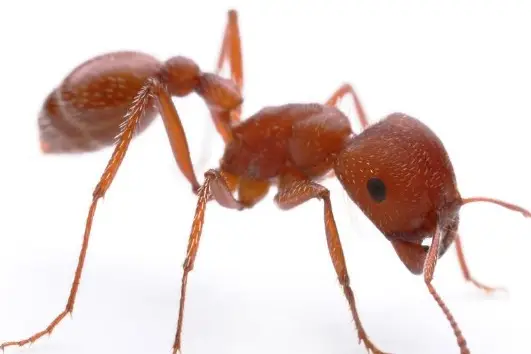
| Scientific Name | Pogonomyrmes barbatus |
| Size | 6-7 mm |
| Color | Orangish-red, maroon |
| Location | native to the Southwestern United States |
On the 16th position on our list of Biggest Ant species, we have the Red Harvester Ants. These are pretty large, with an average body length of 6-7 mm. The Red Harvester Ants primarily feed on plant products and may sometimes exhibit mutualism with particular plant species.
They exhibit solid social behavior and are fierce defenders of their colonies. Their sting is considered to be painful and venomous, causing inflammation and allergies.
15) Red Wood Ant
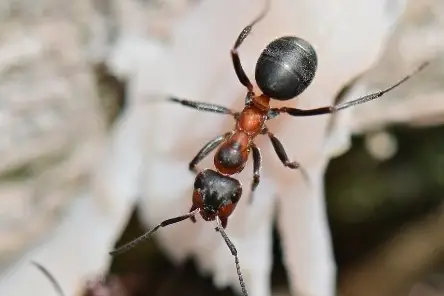
| Scientific Name | Formica rufa |
| Size | 4.5-9 mm |
| Color | head and thorax are colored red and the abdomen brownish-black |
| Location | native to Europe and Anatolia; also found in North America |
The Red Wood Ants, or Formica rufa, is a large ant species with a characteristic brownish-black color and a dark patch in their hind region. These ants are generally 5-9 mm in length and primarily feed on honeydew secreted by aphids.
The Red Wood Ants are known far and wide for their defense mechanism, which is spraying formic acid from their abdomen.
14) Ectatomma ruidum
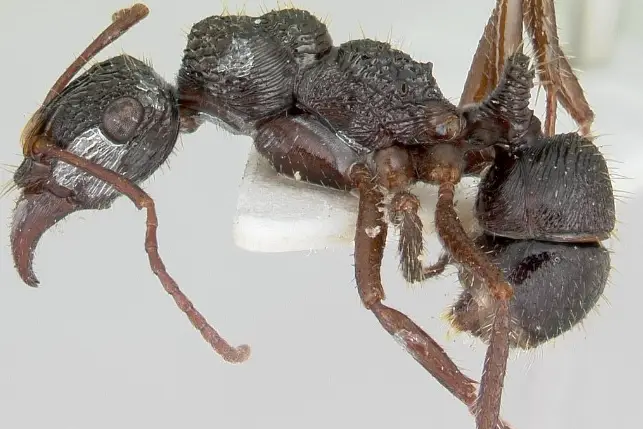
| Scientific Name | Ectatomma ruidum |
| Size | 7-9 mm, and the large queen 11-12 mm |
| Color | Dark reddish brown to blackish brown |
| Location | from southern Mexico to Brazil |
Ectatomma ruidum are medium-sized ants with a wide range of distribution from southern Mexico to Brazil, including Honduras, Costa Rica, Panama, Colombia, Venezuela, Ecuador, Nicaragua, Guadeloupe, Trinidad and Tobago, and Guyana.
They have a simple nest (just a hole in the ground) and can be found easily where the sun is exposed. These ants mainly feed on nectar but don’t solely depend on it and are capable of adapting according to the available resources.
13) Formica fusca
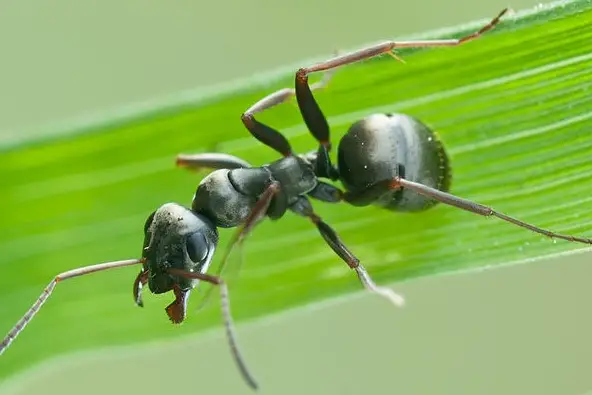
| Scientific Name | Formica fusca |
| Size | 8-10 mm, (0.3–0.4 in) |
| Color | brownish-black |
| Location | Europe, Southern Asia, and Africa |
Next on our list of the biggest ant species, we have the Formica Fusca. These ants are black, with the worker ants being quite large, 8-10 mm in length.
F. fusca primarily feeds on honeydew, moth larvae, and nectar. They usually make their nests below old tree stumps or under stones and boulders.
12) Weaver Ants
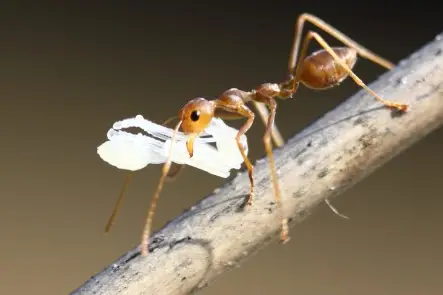
| Scientific Name | Oecophylla smaragdina |
| Size | 8-10 mm (0.31–0.39 in) |
| Color | reddish to yellowish brown |
| Location | Africa, India, Sri Lanka, and Australia |
Green ants, commonly known as Weaver ants, are the 12th largest ants on the list. This species is widespread around the globe for its unique nest-building skills with its larval silk.
Weaver ants depend on various arthropods that wander near their nest for their protein source.
Apart from this, they feed on honeydew, secreted by multiple aphids. They exhibit strong social behavior and work coordination and are highly territorial.
11) Banded Sugar Ants
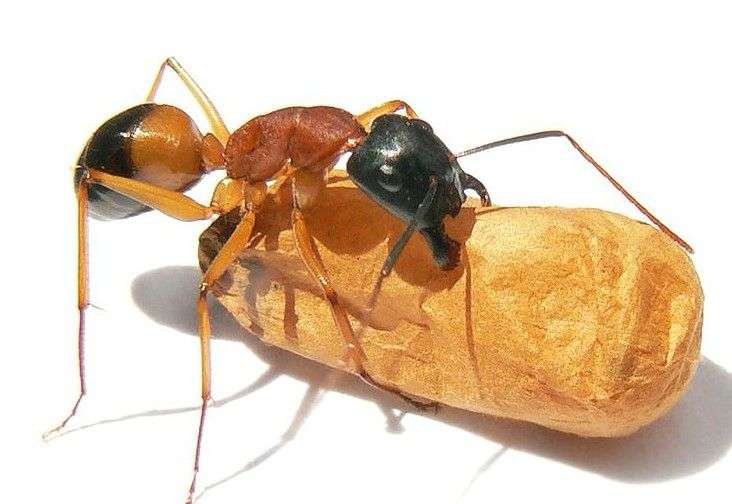
| Scientific Name | Camponotus consobrinus |
| Size | 4 to 16 mm |
| Color | Black with orange-brown bands |
| Location | Eastern Australia |
Let’s start the list with Banded Sugar Ants. These ants are medium-sized, generally occurring in lengths of a wide range from 4mm to 16mm.
The average life span of workers-ant is up to seven years, whereas a queen can live up to 15 years. These ants are primarily nectar feeders but may sometimes forage on aphids, moth larvae, cockroaches, and beetles.
These ants are predatory, where they use their mandibles to hold their prey and use formic acid to kill it. The soldier ants may inflict a painful bite on humans, and the formic acid they spray is quite harmful to human skin.
The Banded Sugar Ants get their name from their affinity towards sugar, which they retrieve from aphids.
10) Black Carpenter Ant
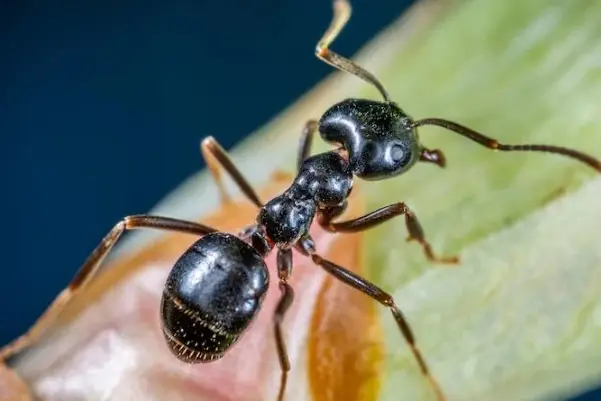
| Scientific Name | Camponotus pennsylvanicus |
| Size | 14-17 mm, Queen: 19-21 mm |
| Color | black |
| Location | Central and Eastern USA and Canada |
The upcoming species are undoubtedly some of the largest ants in the world. In the 10th position, with an average body length of 10-25 mm, we have the Black Carpenter Ants.
These ants derive their name from their habit of nesting in woods. They use their strong mandibles to create tunnels within the woods.
The Carpenter Ants consist of a wide spectrum of species that range up to thousands. They feed on a variety of stuff, which include other insects, honeydew, and nectar.
9) Leafcutter Ant
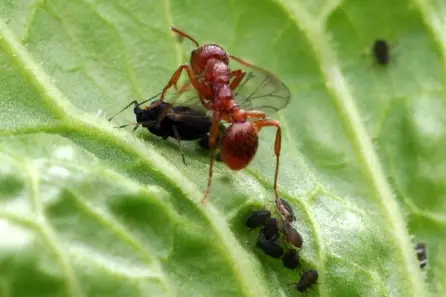
| Scientific Name | Atta cephalotes |
| Size | 3-23 mm, and queen 29-30 mm |
| Color | brownish-orange |
| Location | South and Central America |
The species of Leafcutter Ants, Atta cephalotes, are very beautiful ants predominately in bright orange color. They have a wide range of lengths where the shortest worker-ant can be 3mm whereas the largest soldier-ant can reach up to 23mm.
These leafcutter ants are very special because they cut many different types of leaves to feed fungi and help them to grow. And they also feed only on leaves.
8) Trap-Jaw Ants
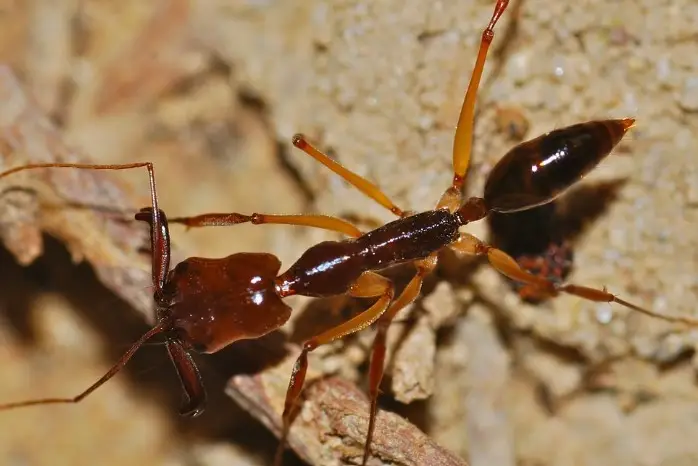
| Scientific Name | Odontomachus bauri |
| Size | 4-20 mm |
| Color | dark reddish brown |
| Location | tropical South America, West Indies, and the Galapagos Islands |
The Trap Jaw genus of ants is undoubtedly one of the largest ants in the world. They are characterized by the presence of a pair of large, straight mandibles that live side by side with each other.
These are immensely strong and can instantly snap and shut the prey in their grip. These ants follow an omnivorous diet, but the larva is carnivorous.
7) Siafu Ants
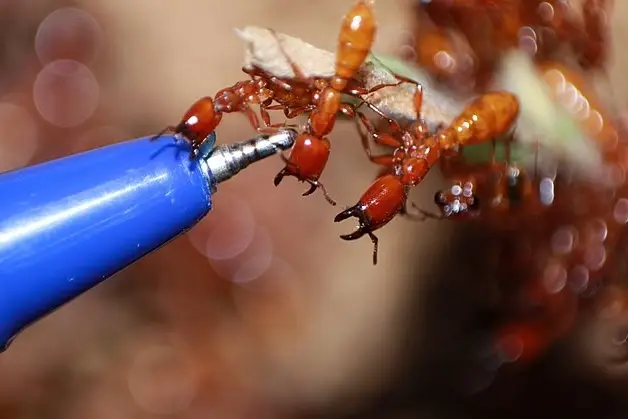
| Scientific Name | Dorylus gribodoi |
| Size | 10-20mm |
| Color | Red, brown, and black |
| Location | Widespread distribution; found in almost all continents |
The Siafu Ants, better known as the Driver Ants, are not a single species but are a Genus and consist of as many as 63 large species of ants. These army ants differ from other Genera in their huge population, which may sometimes be as many as 20 million individuals.
The Driver Ants are known for their migration, where the colony moves in the form of columns. The soldier ants are characterized by their large heads and strong mandibles. Smaller arthropods serve to be their primary diet.
6) Cephalotes atratus
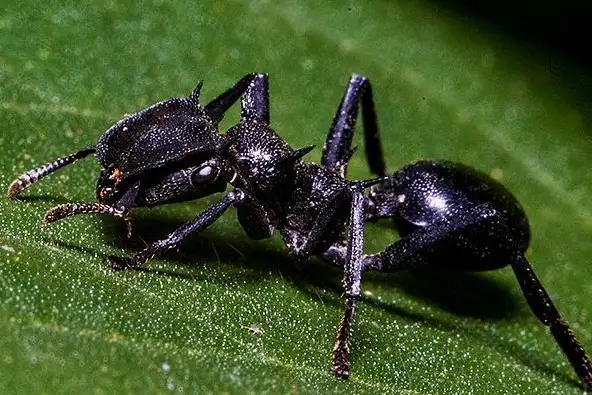
| Scientific Name | Formica rufa |
| Size | 8-20 mm |
| Color | black |
| Location | South American Rainforests like Argentina, Brazil, and Panama |
The Cephalotes atratus, with an average length of 8-20 mm, is the 6th biggest ant on the list. The Queen of this species may attain a body length of 23 mm.
These are primarily herbivores, with pollen occupying a major share of their diet. These species are characterized by the presence of two angular spines on their heads.
5) Matabele Ant
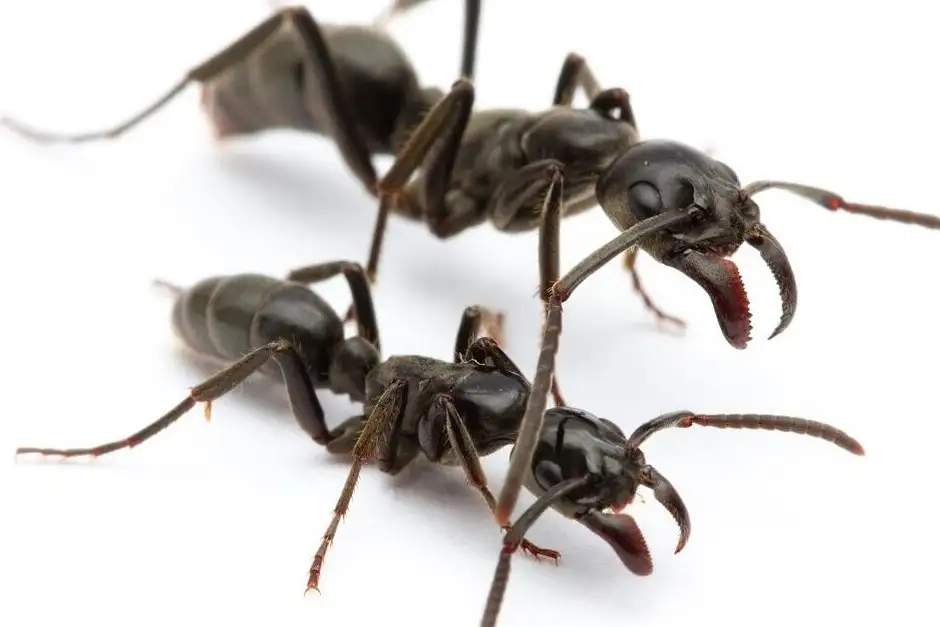
| Scientific Name | Megaponera analis |
| Size | 5-25 mm |
| Color | shiny black |
| Location | throughout sub-Saharan Africa |
Matabele Ants are one of the largest species of ants where some individuals reaching up to 25mm in length. They primarily feed on termites and love to nest in abandoned termite hills.
Their colony comprises 440 to 2300 adult ants. Also, Mataele ants are known for their helpful behavior. They save the injured ants and provide them with treatment.
4) Bullet Ant

| Scientific Name | Paraponera clavata |
| Size | 18-30 mm |
| Color | reddish-black |
| Location | inhabitants of humid lowland rainforests in Central and South America |
Bullet Ants are a large species of ants, occurring up to a length of 18-30 mm for worker ants. The stings of these ants are immensely painful and are often compared to that of a bullet piercing the skin into the body, thereby earning him the name.
Their sting is the most painful one, among all insects, with an alarming rating of 4.0 on Schmidt’s Index.
3) Giant Forest Ant
| Scientific Name | Dinomyrmex gigas |
| Size | 20-30 mm |
| Color | dark red, light brown & black |
| Location | the rainforest in Southeast Asia from Thailand, Sumatra, Borneo, Malaysia to Singapore |
The Giant Forest Ants comprise the 3rd biggest ants on the list. These ants grow a size of 21 mm for workers, while the soldiers may grow an enormous length of 28 mm on average.
Despite their gigantic size, they are primarily honeydew feeders and are found to harvest aphids. However, their diet may sometimes shift to a carnivorous one when they hunt for smaller or dead insects.
The head and thorax are mostly black, while the abdomen takes a darker shade of red.
2) Giant Bull Ant
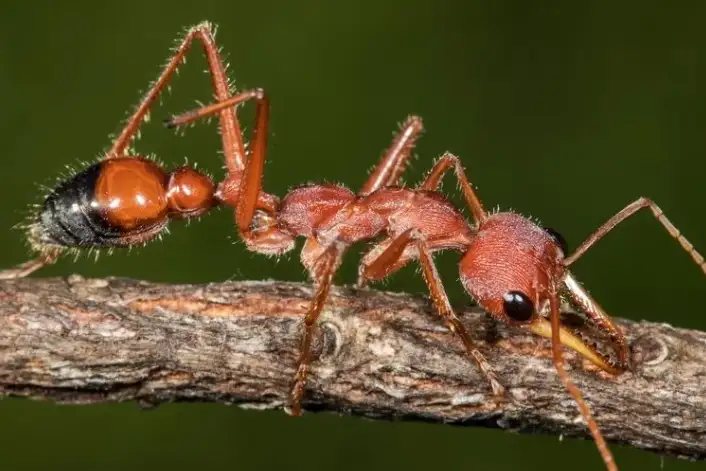
| Genus | Myrmecia |
| Size | 8-40 mm |
| Color | bright red or orange & black |
| Location | Mostly found in the Australian Capital Territory and the Murray-Darling Basin |
Giant Bull Ants are quite enormous, with an average body length of workers being 28-40 mm.
They pose quite large mandibles, which they use to catch their prey or as defense weapons. Red Bull Ants are known for their potent sting, and the pain can last up to a couple of days.
1) Dinoponera or Giant Amazonian Ants
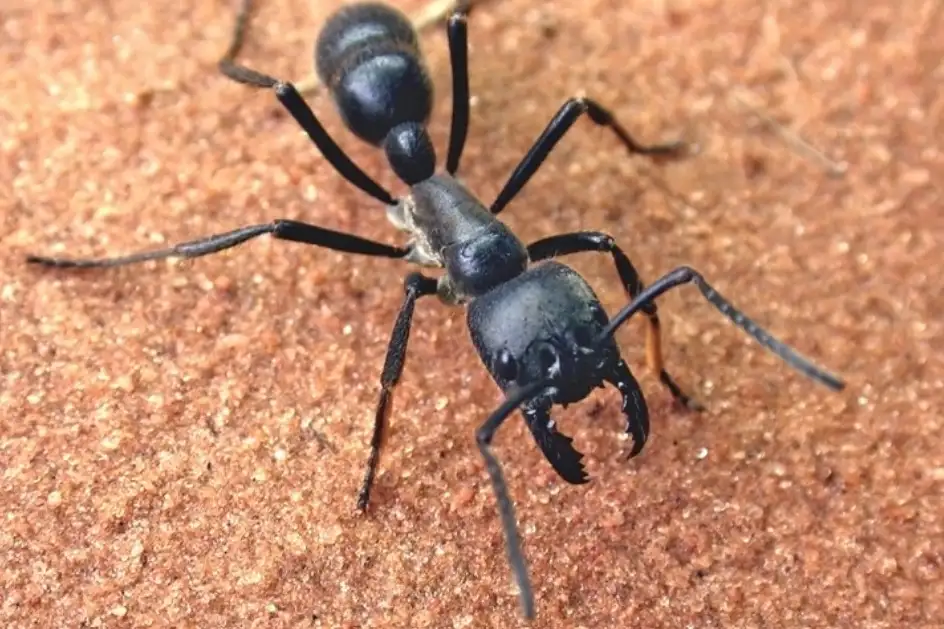
| Scientific Name | Dinoponera gigantea |
| Size | 30-40.64 mm, (1.2–1.6 in) |
| Color | coal-black, dark red |
| Location | Eastern slope of the Andes, Ecuador, and south through Bolivia, Paraguay, and Argentina |
Dinoponera gigantea is the largest ant in the world. Commonly known as the Giant Amazonian Ants, they are giants in the true sense. They grow up to an enormous length of 1.3-1.6 inches, with the females being much larger than the males.
These ants are widespread in the South American Rainforests and are coal-black in color. They forage mostly on seeds and plant products but may sometimes shift their diet to smaller animals like snails, spiders, and other insects.
Special Mention:
Dorylus Gribodoi Ant Queen
Apart from the list of largest ants in the world, a special mention goes to the Queens of Army Ants, belonging to the Genus Dorylus. The Queens of Dorylus Gribodoi is the largest known living ant, with a size range of nearly 1.6- 2.5 in (40-65 mm).
Their heads are quite large, equipped with strong mandibles, which are as sharp as a scissor. The Queen’s primary function is to lay eggs and carry the generation forward.
The Dorylus Ant’s colonies have only one queen, who may lay up to 1,000,000 eggs a month.
Here, we conclude our article on the Top 15 biggest ant species in the world. We will be back with more such interesting articles shortly. So stay tuned, or you can even read our other articles on the website.
Image Source: Wikipedia
Also Read:

Meet Monty, the visionary founder of How It See, being an engineering student, he’s fueled by an insatiable curiosity about the world around him. He is captivated by an eclectic correlation between animal groups, science, and nature, and this fascination drives his quest for understanding.
After completing his degree, he’s set on a mission to delve deep into the realm of nature, accumulating knowledge to share with you through his writing. In the meantime, he loves to watch anime and read anime.
